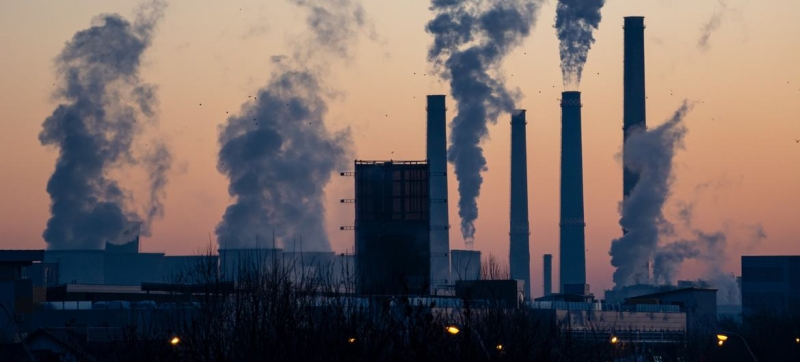
Fossil fuel power plants pollute the air with greenhouse gases that cause climate change. Countries must cut greenhouse gas emissions by 42 percent by 2030 Climate and Environment
Countries must collectively commit to cutting annual greenhouse gas emissions by 42 percent by 2030 and 57 percent by 2035, the United Nations Environment Programme (UNEP) said. Otherwise, the Paris Agreement goal of keeping global temperature rise to 1.5 degrees Celsius will become a mirage in just a few years.
As highlighted in the UNEP report published today, states must make corresponding commitments within the framework of the next round of development of nationally determined contributions (NDCs) to reduce emissions, which will be presented next year ahead of the 30th UN Climate Conference in Brazil (COP-30).
Recall that, according to the agreements enshrined in the Paris Agreement on climate, the increase in global temperature – by reducing harmful emissions – must be kept within 1.5 degrees Celsius, otherwise the consequences of climate change will become catastrophic for humanity.
“Record emissions mean record sea temperatures, fueling monstrous hurricanes. Record heat turns forests into powder kegs and cities into saunas. Record rains lead to floods of biblical proportions,” UN Secretary-General António Guterres said in a statement announcing the report’s release.
Global mobilization on an unprecedented scale
Experts estimate that unless countries raise their NDC targets and begin implementing them immediately, the planet could warm by 2.6 to 3.1 degrees Celsius over the course of this century. The consequences would be devastating – for people, economies and the planet. Moreover, the probability of scenarios that could lead to such an increase in temperature is 66 percent.
“This is a climate crisis. We need global mobilization on an unprecedented scale and pace, starting now and before the next round of climate commitments – or the 1.5 degree Celsius target will soon no longer be realistic,” said Inger Andersen, UNEP Executive Director.
She called on countries to use the upcoming COP29, which will take place in Baku in November, to step up climate action.
Read also:
INTERVIEW | Baku prepares to host the world’s largest climate conference
“Even if the world exceeds 1.5 degrees Celsius – and the chances of this are growing every day – we must continue to strive for… a world with zero emissions. Every fraction of a degree matters in terms of lives saved, economies protected, damage prevented, biodiversity preserved,” Andersen said.
The report also looks at what it would take to keep global temperature rise to at least 2 degrees Celsius, by cutting emissions by 28 percent by 2030 and 37 percent by 2035.
Keeping it under 1.5 degrees is still possible
The report shows that humanity has the potential to cut emissions by more than 50 percent by 2030, but it will require a huge effort.
Wider deployment of solar photovoltaic and wind power could provide 27 percent of the total reduction potential by 2030 and 38 percent by 2035. Forest conservation and restoration activities could provide about 20 percent of this potential. A shift to alternative fuels in construction, transport and industry would also be necessary.
This potential demonstrates the possibility of achieving the COP28 targets of tripling renewable energy capacity by 2030, doubling the average annual rate of improvement in energy efficiency by 2030, eliminating fossil fuels, and conserving and restoring ecosystems.
However, realizing even part of this potential will require unprecedented international mobilization. For example, achieving net zero emissions requires at least a sixfold increase in investment in mitigation measures, supported by reform of the global financial architecture, decisive private sector action, and international cooperation.
Additional investment for these purposes is estimated at $0.9-2.1 trillion per year between 2021 and 2050. UNEP emphasizes that these investments will yield returns in the form of reduced costs associated with the impacts of climate change and air pollution, including environmental damage and impacts on human health. For comparison, the size of the global economy and financial markets is estimated at $110 trillion per year.
The G20 countries bear the main responsibility
The G20 countries, responsible for the bulk of emissions, must do the bulk of the work in combating climate change. However, the group is still behind schedule in meeting its commitments even under its current NDCs.
The G20, excluding the African Union, accounted for 77 percent of global emissions in 2023. However, if the emissions of the 55 African Union countries are included, the figure increases by only 5 percent to 82 percent, highlighting the need for differentiated responsibilities among countries.
The UN chief stressed that finance will be a central theme at COP29 in Baku.
“Developing countries urgently need serious support to accelerate the transition to clean energy and to cope with the devastating weather events they have already faced. A new financial target must be agreed at COP29 to provide the trillions of dollars they need,” Guterres said.
